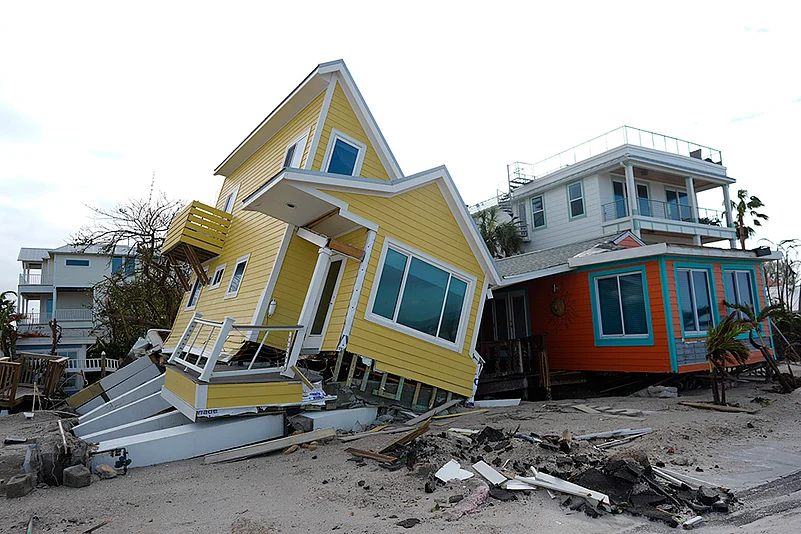Residents across Florida began the slow process of recovery on Saturday after Hurricane Milton brought widespread damage and power outages to the state. The storm, which hit Florida on Wednesday as a Category 3 hurricane, left roads in many areas impassable, and resources scarce for those trying to return home. Power restoration efforts were underway, but thousands of homes and businesses were still without electricity.
Milton made landfall on the Gulf Coast, slamming into Sarasota County before moving across the state, leaving destruction in its wake. The hurricane’s powerful winds and heavy rain caused severe damage to homes, infrastructure, and communities, and also triggered deadly tornadoes. Authorities have confirmed at least 17 deaths across Florida, and reports of damage are still coming in from many areas.
Federal Help for Recovery Efforts
On Friday, President Joe Biden approved a disaster declaration for Florida, allowing federal funds to be used for recovery. These funds will support temporary housing, home repairs, and provide loans for those affected by the storm. More than half of the counties in Florida will receive assistance as they work to rebuild and recover from Milton’s destruction.
Many areas were still reeling from the effects of Hurricane Helene, which hit just two weeks before Milton. The back-to-back hurricanes have left parts of the state in disarray, with some communities now dealing with their second major cleanup effort in a matter of days.
As of Saturday afternoon, about 1.3 million homes and businesses remained without power, though the number was down from more than 2 million the previous day, as reported by USA Today. Many residents without electricity were scrambling to find ice to save food from spoiling, as outages dragged on.
Gas Shortages Add to the Strain
In major cities like Tampa, Sarasota, and St. Petersburg, a gasoline shortage added to the challenges residents faced in the aftermath of the hurricane. Many gas stations ran out of fuel, forcing drivers to wait in long lines that stretched for miles at the few locations still open. The situation showed signs of easing on Saturday, as ports reopened to receive fuel shipments, and officials promised more deliveries over the weekend.
To help with the fuel shortage, Governor Ron DeSantis announced the opening of three free fuel distribution sites in Plant City, Bradenton, and St. Petersburg. Residents could receive up to 10 gallons of gasoline at no charge. DeSantis also said that additional distribution sites would be set up soon as fuel deliveries continue to arrive.
Meanwhile, in Orlando, some of the state’s major tourist attractions, including Walt Disney World and Universal Orlando, reopened on Friday, signaling a gradual return to normalcy in certain areas. Port Canaveral, a key hub for cruise ships and cargo traffic, also resumed operations.
Flooding and Warnings in Flagler County
Flagler County, located on Florida’s east coast, faced its own set of problems after Milton passed through. Local officials urged the more than 130,000 residents to stay off the roads and limit water use to emergencies only, as the county’s water treatment plants struggled to keep up with demand. The Florida Air National Guard arrived on Saturday to help distribute ready-to-eat meals to those in need.
Authorities across the state warned residents to be cautious as they navigate the post-storm landscape. Power lines knocked down by the storm pose a significant danger, particularly in areas still dealing with flooding or piles of debris. Officials in Flagler County advised people to avoid downed power lines and stay away from flooded areas, where hidden hazards could be present.
Rescues Continue as Water Levels Rise
While Milton has moved out into the Atlantic Ocean, the storm’s impact is still being felt across Florida. Rising floodwaters in Hillsborough, Pinellas, and Pasco counties prompted continued search and rescue operations on Saturday. Rescue teams worked tirelessly to pull people from floodwaters and bring them to safety. Governor DeSantis reported that more than 1,000 people had been rescued as of Saturday morning.
"We were lucky not to see the 15- to 20-foot storm surge that was predicted, but the rising waters have still been very dangerous," DeSantis said, praising the swift response of emergency crews.
Tornadoes and Severe Damage Across the State
Though Tampa Bay avoided the worst-case scenario of a massive storm surge, Milton’s winds and rain still left significant destruction. A crane toppled into a downtown building in Tampa, and Tropicana Field, home to the Tampa Bay Rays, lost part of its roof. Wind speeds of up to 100 mph were recorded as the storm moved inland, causing widespread damage.
In Sarasota County, where Milton made landfall, several tornadoes were spawned by the storm. These tornadoes caused devastation far from the initial impact zone. One tornado in Brevard County tore off the roof of a Wells Fargo bank and flattened nearby buildings.
Flooding also wreaked havoc in other parts of the state. In Polk County, much of the area was left underwater, while in Lake County, a wastewater treatment plant in Leesburg spilled nearly 2 million gallons of sewage water due to the flooding. Downed trees, power lines, and sinkholes were reported across Florida as the storm moved eastward.
17 Confirmed Deaths and Rising Costs
The death toll from Hurricane Milton stands at 17 as of Saturday, with fatalities reported in multiple counties, including St. Lucie, Volusia, Pinellas, and Citrus. Several of the deaths were caused by falling trees, while others were the result of tornadoes or medical emergencies that rescue teams couldn’t reach in time.
In Volusia County, a 79-year-old woman and a 54-year-old woman were both killed when trees fell on their homes during the storm. A man in Orange County died after stepping on a downed power line, a reminder of the many dangers still present in the aftermath of the hurricane.
The financial toll of Hurricane Milton is expected to be staggering. Early estimates suggest the storm caused $50 billion in damage, but that number could rise as more information comes in. According to AccuWeather, the total economic cost could exceed $160 billion, taking into account long-term health care and business losses.
With recovery just beginning, Milton is already being ranked among the most destructive storms in Florida’s history, and it comes on the heels of Hurricane Helene, which caused up to $250 billion in damage just two weeks ago.
















